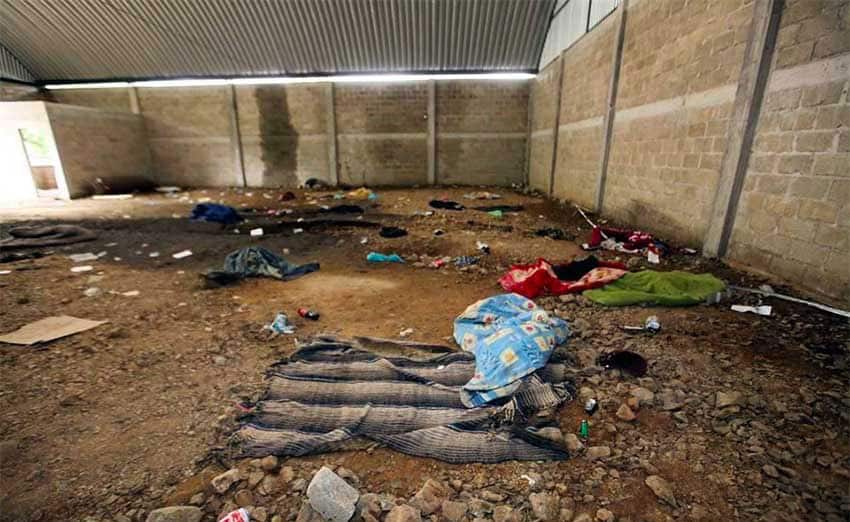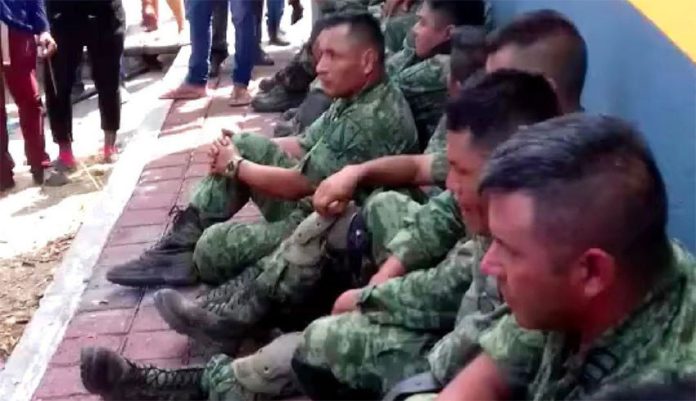Two incidents last month suggest that a passive response by the military when confronted with acts of aggression by citizens could be coming to an end.
Soldiers have been harassed with shovels and brooms, disarmed and detained in recent months by citizens, some of whom allegedly have links to criminal groups.
During each incident, and in many other similar situations, the army – following instructions not to be drawn into confrontations that could turn bloody – chose not to fight back
Retired military generals said in September that at least some of the aggression towards soldiers could have been ordered by crime groups, while Juan Ibarrola, a newspaper columnist and expert on Mexico’s armed forces, told the Associated Press that gangs often use townsfolk as human shields.
One of the most prominent recent acts of aggression against the army was the disarmament and detention of 14 soldiers in La Huacana, Michoacán, in May.
Again, the troops didn’t retaliate in any way, allowing what many people described as a humiliation.
In contrast, President López Obrador praised the troops, declaring that their attitude “was very responsible, very honorable and very brave” and that “prudence is much better than authoritarianism.”
Indeed, López Obrador – who during last year’s presidential campaign used the slogan “hugs, not bullets” to encapsulate what his strategy to dealing with violence would be – has given the army a clear mandate to avoid civilian casualties.
At a gathering of Nobel Peace Prize laureates in Mérida, Yucatán, last month, the president reiterated that he was committed to finding a peaceful solution to the violence plaguing the country.
“What we want is to achieve total peace but we don’t want a peace achieved with authoritarianism, with the use of force. We don’t want a peace of graves . . .” López Obrador said.
For the first nine months of his administration, military personnel heeded the president’s advice and refused to fight back when confronted aggressively by citizens.

However, the army’s response to violent incidents in Querétaro and Puebla in early September showed that it could be growing tired of turning the other cheek.
When an army patrol showed up in the Querétaro community of La Llave on September 7 to stop the looting of a train, they were met by cudgel-swinging residents who threw stones at them.
Two soldiers were injured and residents attempted to disarm them. As that was occurring, someone – presumably a soldier – fired gunshots, the army said, although it added that it was unclear exactly who the shooter was.
Two civilians sustained gunshot wounds, while “the officer leading the patrol fired at the ground,” the Associated Press said.
The next day, the army fired warning shots after a group of about 150 people in Acajete, Puebla, attacked soldiers with clubs and stones in an attempt to gain access to a warehouse where merchandise seized by the military was stored inside tractor-trailers.
No one was injured but for the second time in as many days, the army showed that, unlike in the previous nine months, it was prepared to retaliate.
Security analyst Alejandro Hope said the two incidents were evidence that the honeymoon period of army passivity could be over.
That possibility has generated fears that the military could once again commit severe human rights abuses such as it did in 2014, when soldiers executed killed a band of criminals in a warehouse in Tlatlaya, México state.
While Hope believes that the response of the army to the two events last month could foreshadow more military violence, Ibarrola, the newspaper columnist, has a different view.
“I think there is a commitment [in the military] to show the president that the armed forces will not be the ones to start a fire,” he said.
Ibarrola said that drug cartels and other crime gangs sometimes pay housewives and farmers to act as human shields to hinder the army and warned that if a soldier were to kill a citizen, the damage to President López Obrador and his government would be significant.
“. . . If a woman or a child dies and it was a soldier who killed them, imagine, that would change the whole narrative . . . It would be madness,” he said.
The Associated Press noted that there is a “third way” for the army to respond to aggression: the use of dissuasive non-lethal force.
However, the use of tear gas and Tasers has barely been explored by the armed forces and it is unclear what training soldiers have received in order to be able to respond with proportional force.
The Secretariat of Defense didn’t respond to questions from the Associated Press about what non-lethal weapons and means soldiers have to respond to violence and what training they have received.
Hope, however, pointed out that a middle ground approach has not been adopted in the past by Mexico’s security forces.
“This is a structural problem of the Mexican government,” he said. “Law enforcement forces either used excessive force, or did nothing at all.”
Source: The Associated Press (en)
